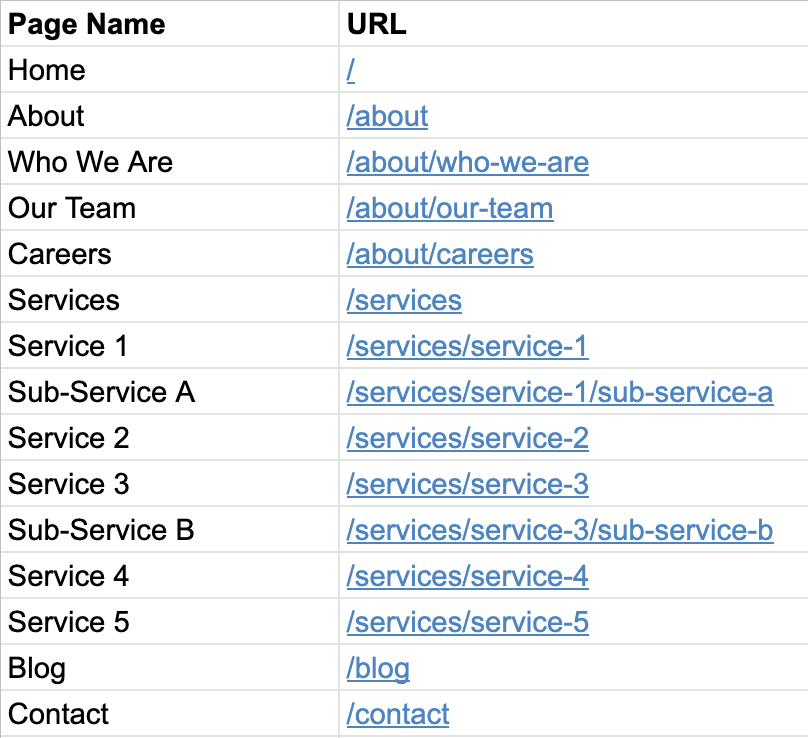Site mapping is the very first stage of our website discovery phase and is pretty much exactly what it sounds like – a map of your website. Before we get too deep into the design and development of your site, we first need to figure out how we want your new site to be structured. This includes things like navigation, page layouts, and content blocks. You’ll work closely with our lead content strategist who will act as your cartographer, mapping out how your site will be laid out and where different elements will live.
What Is A Sitemap And Why Do I Need One?
Now I know we mentioned above that a sitemap is simply a map of your website, which is true, but like most things digital, there’s a bit more to it than that. First things first, it’s important to know the difference between a visual sitemap and an XML sitemap.
Visual Sitemap
This type of sitemap is a visual representation of your website in the form of a flowchart that shows how pages are linked together. This is often a series of boxes with top-level and sub-level navigation items clearly identified and created with the intent of being shared with other humans.
Trying to visualize the structure of your new site can be challenging and confusing at times. That’s why we create a visual sitemap, to help keep information organized and presented in a way that’s easy to understand. This visual sitemap is not only presented to our clients but also used internally by our designers as a guiding framework.

HTML/XML Sitemap
This type of sitemap basically acts as a digital GPS for search engines. Data is pulled from your site to generate a long list of URLs. This list of URLs is yet another way for displaying how your pages are linked together but in a format that is readable by search engines.
According to Google, “A sitemap is a file where you provide information about the pages, videos, and other files on your site, and the relationships between them. Search engines like Google read this file to more intelligently crawl your site.”
In other words, maintaining a well-mapped site means the Google crawlers can easily see what kind of information you offer and send search engine users to your web pages. This is the type of site map that is usually more associated with SEO services.

Our Site + Content Mapping Services
At Matchbox, we create both visual and XML sitemaps. Both are needed when creating a new website with the only real difference being that one is created for the client and one is created for search engines. We will also create a content map which is basically just a more detailed version of a visual sitemap.
Site Mapping
When creating your visual and XML sitemaps, we first want to get a better understanding of how your current site is laid out and the reasoning behind any structural decisions that were made. We achieve this with a discovery call and by creating a sitemap for your existing site. We won’t normally share this map with you since you’re already familiar with the layout of your current site, this is mainly for internal purposes so that we know exactly what we’re working with.
During your website discovery call, we’ll ask a few questions about site structure and content needs. These questions will help give us a clear understanding of what’s currently working and what needs to be improved upon. From there we’ll get to work on putting together the first draft of your visual sitemap.
Content Mapping
Once all the pages have been mapped out and the structure is set, we’ll then take it a step further by mapping out content. We do this by adding brackets underneath each individual page with a list of suggested content blocks. These blocks are listed in ascending order, meaning that the first item on the list is meant to be the first block on the page. For a better idea of what this looks like, we’ve added content to our initial sitemap example that was provided above:

As you can see, adding content helps paint a much more detailed picture of how your site will be laid out. We also want to mention that if you don’t see a page with a bracket underneath, that’s most likely because it uses a template that follows the same structure as the pages above (like the service and sub-service pages in our example). Once we’ve finished completely mapping out your site, we’ll then present it to you. Afterward, we’ll give you plenty of time to review and provide feedback. Once all that feedback has been collected, we’ll make edits, finalize your map, and last but not least, create an XML sitemap based on the client-approved visual map.
We’re Here To Help With Site + Content Mapping!
Restructuring your entire website doesn’t have to be a complicated process. Our goal is to make the entire experience as simple and streamlined as possible. You bring the much-needed industry experience and we’ll bring the structural know-how and together we’ll create a beautifully constructed website. Contact the experts at Matchbox Design Group today and we will get your unique project started in a timely manner. We move as fast as you allow us, so when we ask for the information needed we need timely responses so we can move forward at your pace.
Contact Matchbox Design Group Today!
If your website could use a refresh, if you’re looking to drive more traffic to your site, or you would like to submit a guest post, fill out the form below and we’ll contact you to learn more about your digital needs.